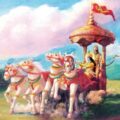The Chronological History of the Chaitra Shukladi Calendar

The Vedic 5-year Yuga calendar was first established in 13322 BCE, beginning with the autumn season (Sharad Ritu). In this system, “Chaitra” was designated as the first month, as the autumnal equinox coincided with Aries (Mesha), and the full moon of the first lunar month occurred in Chitra Nakshatra. This lunisolar calendar adhered to a 28-Nakshatra division of the Zodiac. The Ashvini hymns (7.69.3) of the Rigveda, compiled by Vasishtha Maitrāvaruni, a descendant of Sage Vasishtha, indicate the positioning of the autumnal equinox at Ashvini Nakshatra.
After 2000 years, around 11322 BCE, the calendar was shifted to the Phalguna lunar month. This reform resulted in Phalguna becoming the first lunar month. Consequently, Daksha Prajapati of the Rigvedic era performed the Vedic Yajna and New Year ritual (Agrayana) on Phalguna Purnamasi at Kankhal, Haridwar, circa 11217 BCE. The Jaiminiya Brahmana (3.386) offers valuable insights into the twelve months of the reformed Rigvedic Yuga calendar, starting with Phalguna and concluding with Magha.
Following another 2,000 years, from 11322 BCE to 9322 BCE, it was noted that the autumnal equinox, marking the beginning of Samvatsara (the New Year), aligned with the full moon in the Magha Nakshatra. This prompted further reform in the Vedic Yuga calendar and the introduction of the Māgha Shukladi calendar, replacing the Phalguna Shukladi calendar.
Another 2,000 years later, from 9322 BCE to 7322 BCE, it was observed that the winter solstice had shifted to the Ashvini Nakshatra. By 7322 BCE, Indian astronomers had advanced from basic trigonometry to spherical trigonometry. They recognized that dividing 360 degrees by 27 provided greater precision than by 28, thereby avoiding fractions; thus, a list of 27 Nakshatras, beginning with Ashvini Nakshatra (excluding the Abhijit Nakshatra), was introduced in 7322 BCE. Furthermore, it was acknowledged that maintaining alignment between the seasons and lunar months was unfeasible for periods exceeding 2,000 years. Consequently, they adopted the Nirayana (Sidereal) calendar system to establish a perpetual lunisolar calendar.
Chaitra Shukladi Calendar in Siddhantic Astronomy
Mayasura’s Surya Siddhanta significantly transformed Indian astronomy, leading to the introduction of the Chaitra Shukladi calendar on February 22, 6778 BCE, a Sunday when all planets, the Sun, and the Moon were in a great conjunction in Aries on Chaitra Shukla Pratipada.
As Mayasura belonged to an Asura tradition, astronomers from South and Central India subsequently proposed the Brahma Siddhanta and introduced the Chaitra Shukladi calendar on January 25, 6773 BCE, a Saturday, also on Chaitra Shukla Pratipada. This marked the commencement of the 60-year cycle from 6773 BCE, known as Prabhava Samvatsara. Aryabhata noted that 3600 years elapsed from 6773 BCE to 3173 BCE. Thus, the fourth Yugapada, Kaliyuga, commenced on March 5, 3173 BCE, a Thursday, during Prabhava Samvatsara. This explains why the current year, 2025-2026, is designated as Vishavasu Samvatsara.
Later, Aryabhata’s disciple Latadeva recognized the significance of Mayasura’s Surya Siddhanta due to the epoch of conjunction in Aries. He adopted Mayasura’s method but referenced a Kalpa of 432 crore years from the Brahma Siddhanta tradition, instead of the 72 crore years from the Asura tradition. Thus, Latadeva authored the currently available Surya Siddhanta, considering the epoch of rough conjunction in Mina Rashi on February 17/18, 3101 BCE, Chaitra Shukla Pratipada.
The Sakadvipi Brahmans adhered to the Surya Siddhanta calendar. When the Sakas conquered Ujjain, they introduced the Chaitra Shukladi calendar in 583 BCE. Subsequently, Indian astronomers reformulated the Chaitradi calendar in 78 CE, considering the conjunction of the Sun, Moon, and Jupiter on Chaitra Shukla Pratipada on April 1, 78 CE, a Sunday.
Key Dates in the Chaitra Shukladi Calendar
13322 BCE – Chaitra Pratipada – 5-year Sharad Ritu calendar (Autumnal Equinox at Ashvini)
11322 BCE – Phalguna Pratipada – 5-year Sharad Ritu calendar (Introduction of 12 Rashis and 28 Nakshatra scheme starting from
Mrigashira)
9322 BCE – Magha Shukla Pratipada – 5-year Sharad Ritu calendar (Introduction of 28 Nakshatra scheme starting from Krittika)
7322 BCE – Magha Shukla Pratipada – 5-year calendar (Introduction of 27 Nakshatra scheme starting from Ashvini)
February 22,
6778 BCE – Chaitra Shukla Pratipada calendar of Mayasura’s Surya Siddhanta (Introduction of 12-year cycle and 60-year cycle)
6777 BCE – Introduction of the Saptarshi cycle Calendar of 2700 years and Paitamaha Siddhanta
6773 BCE – Chaitra Shukla Pratipada – 60-year cycle
of Brahma Siddhanta
6777-5577 BCE – Treta Yuga of 1200 years
5577-3177 BCE – Dvapara Yuga of 2400 years
3177 BCE – Kaliyuga of Paitamaha Siddhanta
3173 BCE – Kaliyuga of Brahma Siddhanta (Prabhava when Jupiter is in Aries)
3126 BCE – Kaliyuga from another tradition of a 60-year cycle (Prabhava when Jupiter is in Dhanishtha)
3101 BCE – Chaitra Shukla Pratipada – Latadeva’s Surya Siddhanta
2100 BCE – Vaishakha Shukla Pratipada (Vernal Equinox in Taurus)
583 BCE – Chaitra Shukla Pratipada (Vernal Equinox in Aries)
78 CE – Chaitra Shukla Pratipada (Vernal Equinox in Aries).
Featured image source: Google.
Facebook Comments Box
The following two tabs change content below.

Vedveer Arya
Vedveer Arya is a civil servant and an officer of 1997 batch of Indian Defence Accounts Service (IDAS). A postgraduate in Sanskrit from University of Delhi, he is author of 'The Chronology of India'.






